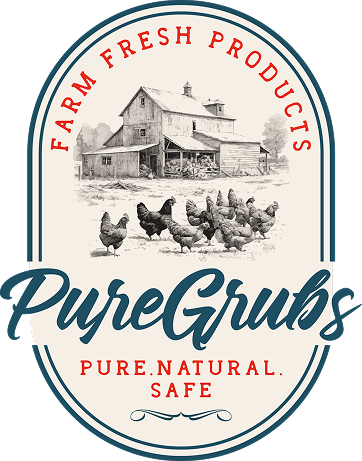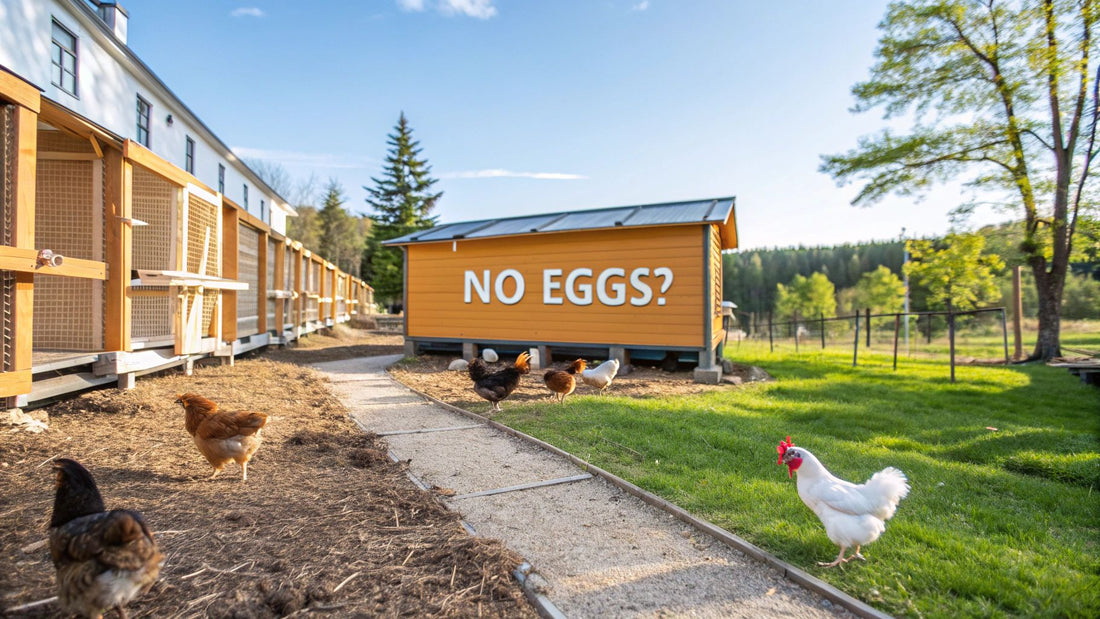
Chickens Not Laying Eggs? Expert Tips to Fix the Issue
Share
If you've walked out to the coop lately and found your nesting boxes disappointingly empty, you're in good company. It's one of the most common head-scratchers for backyard chicken keepers. More often than not, the culprit behind chickens not laying eggs is something simple related to their diet, stress levels, the changing seasons, or a natural part of their life cycle, like molting.
Figuring out the why is the first, most important step to getting those delicious, fresh eggs back in your basket.
Understanding Why Your Chickens Stopped Laying Eggs
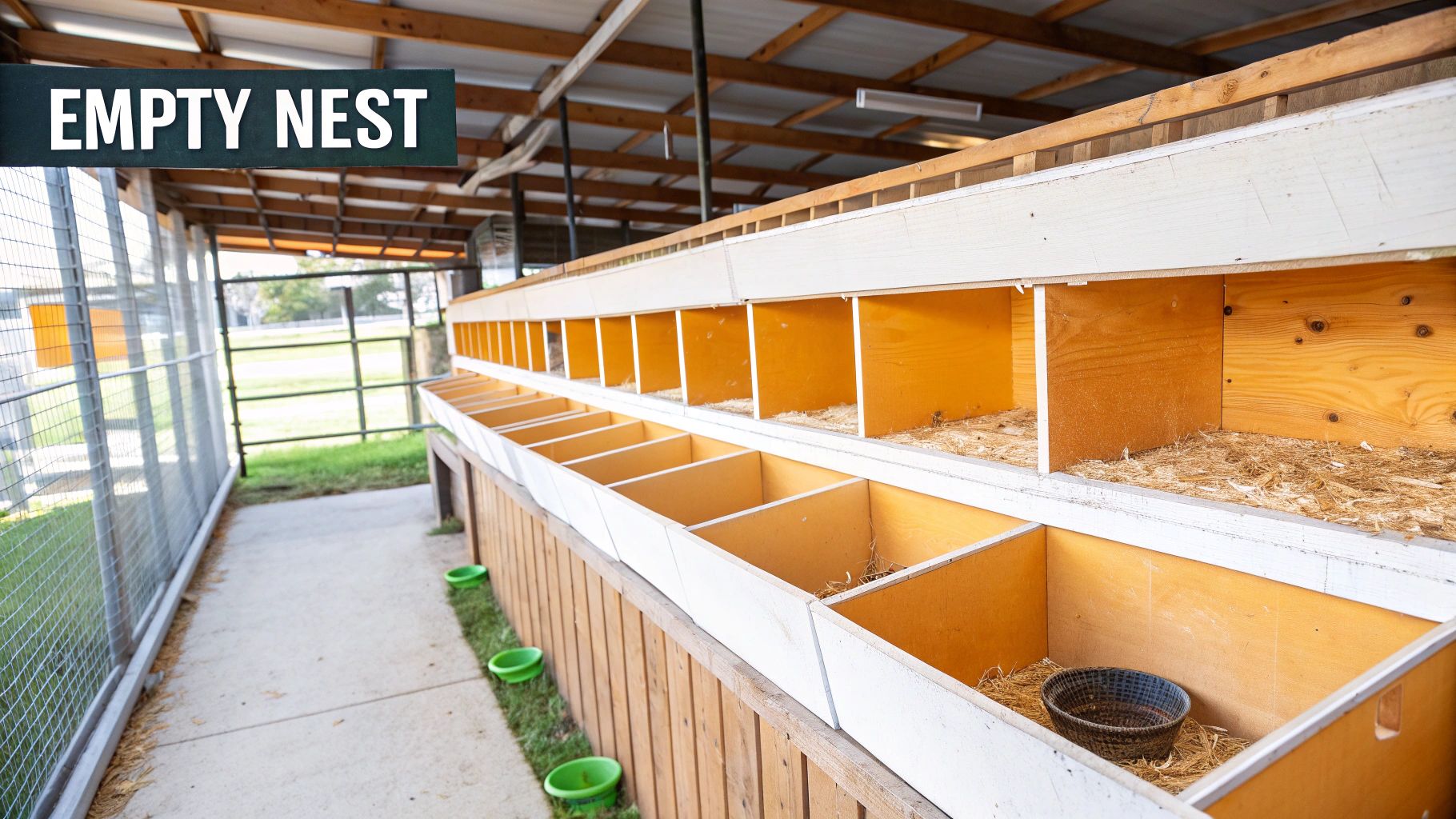
It’s always a little unnerving when your dependable layers suddenly go on strike. One day you’re collecting a full carton, and the next, nothing. This abrupt halt is your hen’s way of sending a clear signal: something isn't right in her world. It could be something obvious, like a hawk circling overhead, or something far more subtle, like a slight dip in the protein content of her feed.
A hen's body is hardwired for one primary job: reproduction. But when conditions aren't ideal, her system hits the brakes on egg production to conserve energy. Think of it as a biological self-preservation switch. Before she puts precious resources into making an egg, her body needs to know that she's safe and healthy first.
The Major Triggers for an Egg Laying Pause
So what flips that switch? Usually, the reasons fall into a few predictable categories. Getting familiar with these will make you a much better chicken detective.
- Nutritional Gaps: A diet lacking in protein, calcium, or even consistent access to clean water can bring egg production to a screeching halt.
- Environmental Stress: Things like overcrowding, predator threats, extreme heat or cold, or even a relentlessly barking dog can stress a hen out enough to stop her from laying.
- Changes in Daylight: This is a big one. Hens need 14-16 hours of light each day to keep their egg-laying hormones firing. The shorter, darker days of fall and winter are a classic reason for a seasonal slowdown.
- Natural Cycles: Sometimes, it’s just nature taking its course. Molting (regrowing feathers), going broody (wanting to hatch eggs), and simply getting older will all cause a temporary, and perfectly normal, break in laying.
A hen’s productivity is a direct reflection of her well-being. An empty nesting box isn't a failure; it's a message that she needs something different from her environment or her diet to feel secure and healthy enough to lay.
Modern hens are bred to be incredibly productive. In the U.S., the average hen lays around 301 eggs per year, thanks to decades of improvements in genetics and nutrition. But even commercial flocks have their off days. Data shows that a daily lay rate can easily drop from 82.5 eggs per 100 hens to under 79 during periods of stress. You can dig into these production stats over at UnitedEgg.com. It's a good reminder that even for the pros, fluctuations are just part of the deal.
To help you quickly narrow down the possibilities, I've put together a simple diagnostic checklist. Take a look at your flock's behavior and environment and see what matches up.
Quick Diagnostic Checklist For Non-Laying Hens
| Symptom or Observation | Potential Cause | Where to Look in This Guide |
|---|---|---|
| Feather loss, bald patches, new feather growth | Molting | Check the Section on Molting |
| Shorter days, fall or winter season | Insufficient Daylight | Check the Section on Light |
| Thin, soft, or missing eggshells | Calcium Deficiency | Check the Section on Nutrition |
| Hen sitting in the nesting box all day, puffed up | Broodiness | Check the Section on Broody Hens |
| New birds introduced, predator attack, recent move | Stress or Social Upheaval | Check the Section on Stress |
| Birds appear lethargic, signs of mites or lice | Illness or Parasites | Check the Section on Health |
| Hen is over 2-3 years old | Age-Related Decline | Check the Section on Age |
This table is your starting point. Once you've identified the most likely culprit, you can jump to the corresponding section for a deep dive into solving the problem and getting your hens back to their happy, productive selves.
What Your Flock's Diet Is Telling You
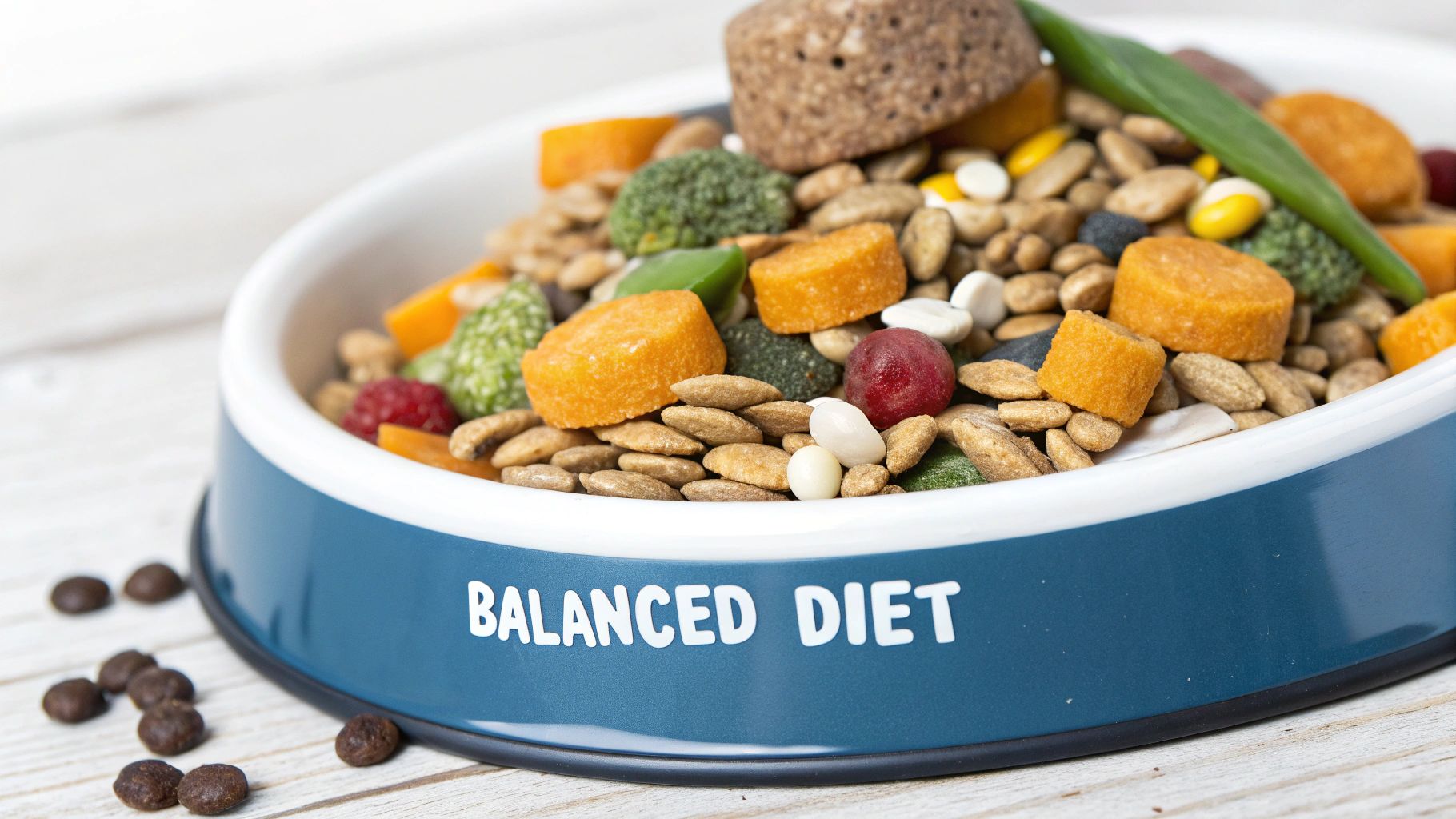
When the nesting boxes suddenly go empty, the first place I always look is the feed bin. A hen is an incredible egg-making machine, but that machine needs the right kind of fuel. Skimp on even one key nutrient, and the entire production line can grind to a halt, sometimes seemingly overnight.
It takes a hen roughly 24 to 26 hours to form and lay a single egg. That’s a demanding biological process that requires a precise cocktail of protein for the albumen (the white) and a massive amount of calcium for the shell. If her diet falls short, her body instinctively prioritizes its own survival over laying eggs.
The Foundation: A Proper Layer Feed
The absolute cornerstone of a productive flock’s diet is a quality commercial layer feed. No exceptions. These feeds are carefully formulated by poultry nutritionists to provide the 16-18% protein and the essential vitamins and minerals a hen needs to lay consistently.
But here’s where a lot of well-meaning flock owners go wrong: they dilute this perfectly balanced diet with too many treats. Tossing out handfuls of scratch grains or a bucket of kitchen scraps might seem like a kind gesture, but it’s like letting a kid fill up on candy before dinner. The chickens get full on the fun stuff and don't eat enough of the essential layer feed, quickly leading to a nutritional shortfall.
As a rule of thumb, keep treats to no more than 10% of your flock’s total food intake. This simple guideline ensures their primary nutrition is always coming from the feed that's actually designed to support them.
Spotting Calcium and Protein Deficiencies
Calcium is, without a doubt, the most critical mineral for a laying hen. An eggshell is almost 95% calcium carbonate, and if a hen can’t get enough from her food, her body will start pulling it from her own bones. This is a recipe for brittle bones, poor health, and, of course, terrible eggs.
You can usually spot a calcium deficiency pretty easily. Look for these signs:
- Thin, flimsy, or soft shells that crack just by looking at them.
- The occasional shell-less "wind egg"—just the membrane holding the yolk and white together.
- A sudden drop in production as her body slams the brakes to conserve calcium.
The fix is simple: always have a separate hopper of crushed oyster shell available for them to eat as they please. It’s called “free-choice” feeding, and it lets each hen take exactly what her body tells her she needs. Another fantastic way to boost calcium is with Black Soldier Fly Larvae (BSFL). They pack a serious punch, containing up to 85 times more calcium than mealworms.
Protein is the other side of the coin. Feathers are over 85% protein, so when a hen goes through her annual molt, her protein requirements go through the roof. Laying almost always stops during this time. You can help them get through the molt faster—and get back to laying sooner—by switching to a higher-protein "feather fixer" feed (around 20-22% protein). For a more complete look at balancing their diet, our guide on what to feed laying hens gets into all the details.
Don't Forget the Water
Finally, let's talk about the most overlooked nutrient of all: water. An egg is about 75% water. If a hen goes without fresh, clean water for even a few hours, especially on a hot day, it can knock her out of lay for days. Make sure waterers are always scrubbed clean and kept full. I even recommend adding a second water source during the summer just to be safe.
How Your Coop Environment Impacts Egg Laying
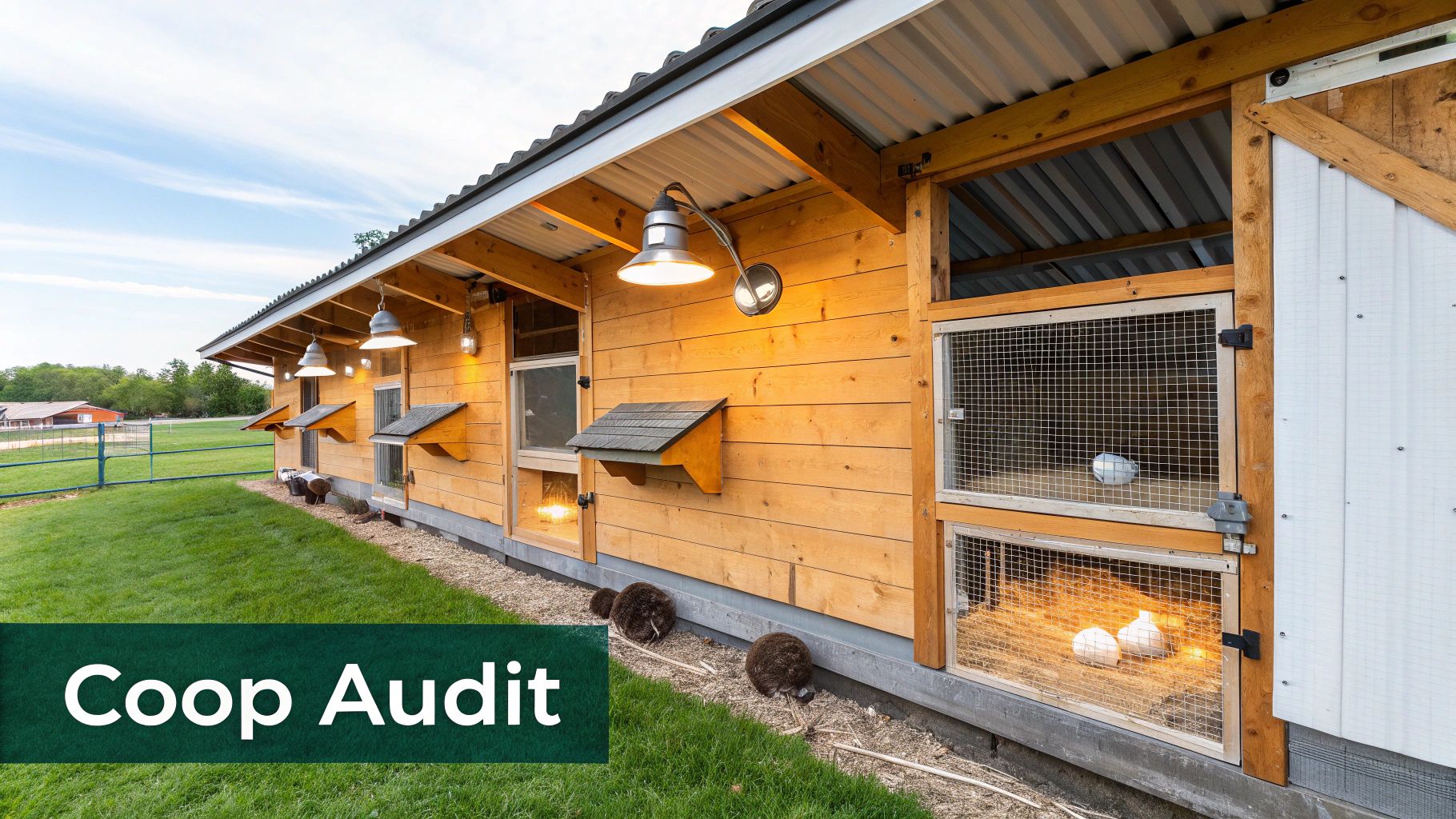
If a hen's diet is the fuel for making eggs, her coop is the entire factory. It's her sanctuary. A coop that feels unsafe, stressful, or just plain uncomfortable will shut down the production line faster than almost anything else.
Chickens are creatures of habit and are incredibly sensitive to their surroundings. Even small changes can signal that it's not a good time to lay. This is why a sudden halt in egg-laying can often be traced right back to the coop itself. Things like overcrowding, the lingering scent of a predator, or even inconsistent light create a low-grade stress that tells a hen's body to stop producing.
The Critical Role of Light
For a laying hen, light is everything. Her entire reproductive cycle is wired to the length of the day, which is why egg production naturally drops off in the fall and winter. To keep laying at their peak, hens need about 14 to 16 hours of light each day.
When the days get shorter, the hormonal signals that trigger laying just switch off. Many chicken keepers are perfectly happy to let their flock take a well-deserved winter break. But if you want eggs year-round, you can easily trick their internal clocks. Adding a simple, low-wattage bulb on a timer to extend the "daylight" hours in the morning or evening is usually all it takes to keep those eggs coming.
Space and Social Harmony
Just like us, chickens need a bit of personal space to be happy. Cramming too many birds into a small area is a one-way ticket to stress. It quickly leads to bullying, feather picking, and squabbles over food and water—all things that tell a hen it’s not safe to lay eggs.
Here are some good minimums to aim for:
- 4 square feet of coop space per bird for standard-sized breeds.
- 10 square feet of run space per bird if they can't free-range.
- One nesting box for every 4-5 hens to avoid traffic jams and competition.
Giving your flock plenty of room helps keep the peace and makes every hen feel secure. This isn't just a backyard flock issue, either. Across Europe, where the laying hen population is around 393 million, housing systems are a massive factor in productivity. While some intensive systems might produce more eggs, free-range birds often face different stressors like predators, which can sometimes lower their output.
Pro Tip: A clean coop is a healthy coop. Ammonia fumes from droppings can cause serious respiratory problems, adding another layer of stress that can stop egg production. A deep, clean layer of absorbent bedding like pine shavings or straw is an absolute must for a productive flock. Our guide on effective chicken coop egg collection has more tips for keeping those nesting boxes clean and inviting.
Take a few minutes to walk through your coop and look at it from your hens' perspective. Check the lighting, the space, and the cleanliness. Often, the reason for your chickens not laying eggs is an environmental stressor that's easy to fix once you spot it. Making their home a predictable and secure haven is one of the most important things you can do to get those nesting boxes full again.
Understanding Health Issues vs. Natural Cycles
When the nesting boxes are empty, it's easy to jump to conclusions. But often, it's just nature running its course. Chickens follow their own internal clocks, which tell them when to lay and when to rest. The real trick for any flock owner is learning to tell the difference between these normal breaks and a genuine health problem.
Before you start worrying, let's look at the two most common—and completely natural—reasons your hens might take a break from laying: molting and broodiness. These are just part of being a healthy, happy chicken.
The Annual Molt: A Feather-Fueled Vacation
Have you ever walked out to the coop in the fall and wondered if a pillow fight broke out? That's the annual molt. Your hens are shedding their old, tired feathers to grow a fresh, new set for the winter. This makeover is incredibly taxing on their bodies.
Growing a full set of feathers demands a massive amount of protein and energy. To pull it off, a hen’s body wisely decides to shut down the egg factory. It's all about resource management. This feather-replacement project can last anywhere from 8 to 12 weeks, and you won't see a single egg during that time. Don't panic—it's a sign she's investing in her own health.
When a Hen Gets "Broody"
The other natural pause happens when a hen’s maternal instincts go into overdrive. We call this "going broody." She decides her life's purpose is to hatch a clutch of eggs, whether they're fertilized or not. A broody hen will stop laying entirely, puff up her feathers like a feathered basketball, and plant herself firmly in a nesting box.
She’ll guard that spot with her life, often letting out a deep, guttural squawk if you so much as look at her funny. While it's a natural instinct, it brings egg-laying to a screeching halt. If you let her be, she might stay broody for a month or more.
Key Takeaway: A hen that looks a bit ragged in the fall is probably just molting. A hen who refuses to leave the nest is likely broody. Both are normal reasons for a laying pause and not usually a cause for alarm.
Spotting the Red Flags of Illness
While molting and broodiness are expected, a sudden halt in laying can also be the first whisper of an underlying health issue. This is where you need to put on your detective hat. The usual suspects are parasites—internal worms or external pests like mites and lice—which can literally drain a hen of the nutrients she needs to produce eggs.
More serious illnesses can also be a factor. We saw this on a massive scale when Avian Influenza hit commercial flocks in the U.S. The national laying hen population dropped by 5% in a single year, highlighting just how quickly disease can shut down production. You can read more about the impact of these flock health events on Feedstuffs.com.
To help you figure out what you're dealing with, this chart breaks down the key differences between a natural cycle and a potential health problem.
Natural Cycles vs Health Problems: A Comparison
This table will help you distinguish between a normal, non-laying period and a situation that might need your attention.
| Condition | Key Symptoms | Typical Duration | Recommended Action |
|---|---|---|---|
| Molting | Feather loss, new pinfeathers, reduced activity. Looks "scruffy." | 8-12 weeks | Increase protein intake. Minimize stress. |
| Broodiness | Stays in nest box, puffed-up feathers, aggressive/protective behavior. | 3+ weeks | "Break" the broodiness if desired, or let her sit on dummy eggs. |
| Parasites | Pale comb/wattles, weight loss, lethargy, diarrhea. | Ongoing until treated | Perform a physical check for mites/lice. Consider a fecal test for worms. |
| Illness | Lethargy, isolation, changes in droppings, sneezing, pale comb, loss of appetite. | Varies by illness | Isolate the hen, consult a vet, and observe the flock for more symptoms. |
Knowing these signs is a good starting point for figuring out your next steps and getting your flock back on track.
This infographic gives you a simple, three-step process to follow.
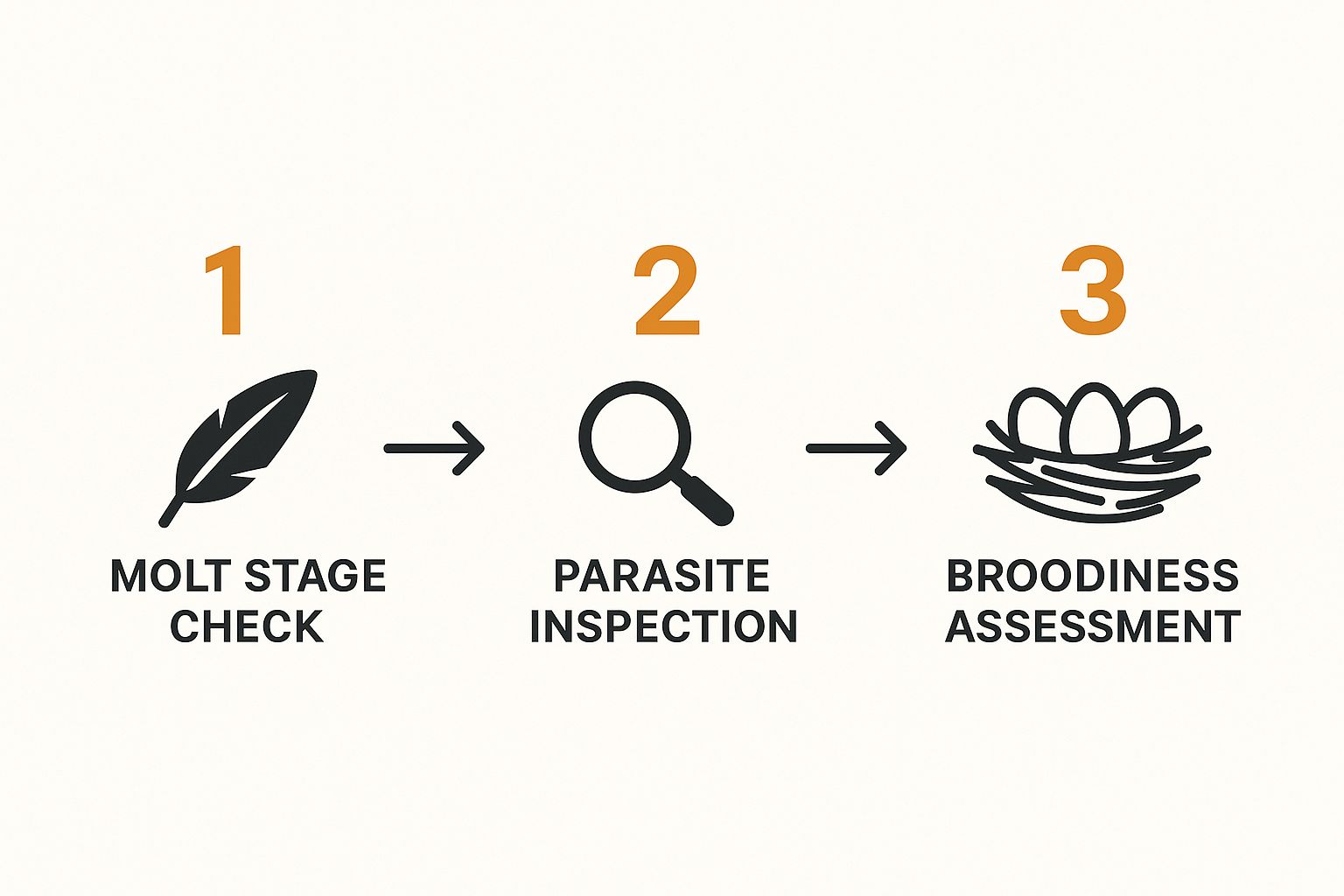
By working through these checks, you can quickly rule out the common natural causes before digging deeper into potential health issues.
Nothing beats a regular, hands-on health check. A healthy chicken is alert, active, and has bright, clear eyes. If one of your non-laying hens is also lethargic, has a pale comb, or just seems "off," it’s time for a closer look. For a deeper dive, check out our complete guide to the symptoms of illness in chickens. Catching problems early is the best way to keep your flock healthy and productive.
Your Action Plan to Get Eggs Again
Alright, you've done the detective work and have a good idea of why your hens are on strike. Now it's time to roll up our sleeves and get those nesting boxes full again. Just knowing the problem isn't enough—taking the right steps is what brings back the eggs.
The key here is not to overwhelm your flock (or yourself) by trying to fix everything at once. Pick the most likely culprit from your diagnosis and start there. From my experience, small, consistent tweaks work wonders, while a massive coop overhaul can just add more stress to the situation.
Revitalize Their Diet and Nutrition
Nine times out of ten, a slump in egg-laying starts with what's in the feed bowl. Nutrition is the absolute bedrock of egg production, and even a small deficiency can shut the whole factory down. The good news? This is often the quickest fix.
- Take a Hard Look at Their Feed: Are you using a quality layer feed with 16-18% protein? Check the date on the bag. Feed that's been sitting in the shed for six months has lost a lot of its nutritional punch.
- Switch Feeds Slowly: If you need to change their food, don't just swap it out. A sudden switch can cause digestive upset, which is just another stressor. Mix the new feed in with the old over a week, gradually upping the amount of the new stuff.
- Offer Calcium on the Side: This is non-negotiable for strong shells. Don't mix oyster shell or crushed eggshells into their main feed. Instead, put it in a separate dish, free-choice. Hens are smart; they'll take exactly what their bodies need, when they need it.
- Give Them a Purposeful Boost: This is where high-calcium treats like Black Soldier Fly Larvae really shine. They're a fantastic way to supplement their diet naturally, supporting shell quality and giving them a protein kick without diluting their core nutrition.
A quick rule of thumb: treats should never make up more than 10% of your flock's daily food intake. Think of them as a supplement, not a replacement for their balanced layer feed. This keeps them from filling up on "junk food" and missing out on the essentials.
Optimize the Coop Environment
A hen that feels unsafe or stressed simply won't lay. Her body diverts all its energy into survival mode, not reproduction. A quick walk-through of your coop can often reveal some surprisingly easy fixes.
First, think about light. If it's fall or winter, the shorter days are almost certainly the issue. A simple light on a timer to give them 14-16 hours of light each day can make all the difference. You don't need anything fancy; a single low-wattage bulb is usually enough to keep the eggs coming through the darker months.
Next, check on the flock's social life. Is one hen getting picked on? Is there a traffic jam at the feeder? Make sure you have at least one nesting box for every four hens and plenty of roosting space. Sometimes, simply adding a second feeder or waterer at the other end of the run is enough to ease tension and bring peace back to the coop.
Address Health and Behavioral Issues
If you've got a hunch that a health problem is the culprit, you need to act fast. For pests like mites, a deep clean of the coop followed by a dusting of poultry-safe diatomaceous earth will usually knock them out. If you suspect internal parasites, it's best to get a vet's opinion for a proper diagnosis and treatment.
And then there's the broody hen. A hen determined to hatch eggs that aren't there can be a stubborn one! To gently "break" her of it and get her laying again, you can:
- Consistently remove her from the nesting box throughout the day.
- Set up a "broody breaker." This is just a wire-bottomed cage with food and water. Placing her in it for a few days allows air to circulate underneath her, which helps cool her body temperature and reset her hormones.
By working through these areas one by one—diet, environment, and health—you're creating the perfect conditions for your hens to do what they do best. A little patience and these targeted fixes will almost certainly have you enjoying fresh eggs again soon.
Even after you’ve run through the usual suspects, you might still be scratching your head about a few things. Let's tackle some of the most common questions I hear from other chicken keepers.
How Long Can a Chicken Go Without Laying an Egg?
Well, that really depends on why she stopped. A hen might take a day or two off for something as simple as a loud thunderstorm or a new dog sniffing around the coop. No big deal.
But during a heavy molt, it's a different story. Expect her to completely stop laying for 8 to 12 weeks. All her energy is going into growing a new set of feathers. A broody hen is even more stubborn; she won't lay a single egg until that motherly instinct is broken, which can take a month or more if you don't intervene.
While a healthy hen in her prime rarely skips a beat, older girls (think 3+ years) will naturally take longer and more frequent breaks between their laying cycles.
Here's a good rule of thumb: If a healthy-looking hen under two years old stops laying for over a week and she's not obviously molting, it's time to play detective. Start digging into her diet, environment, and any hidden stressors.
Does a Rooster Make Hens Lay More Eggs?
This is one of those classic chicken myths that just won't quit. The short answer is no, absolutely not. A rooster has zero impact on the number of eggs a hen produces. Hens are hardwired to lay eggs whether there’s a guy around or not.
A rooster’s only role is to fertilize the eggs, which you only need if you're hoping to hatch some chicks. Now, a good rooster can sometimes help calm the flock and keep everyone in line, but his presence doesn't magically flip on the egg-laying switch. A hen’s production all comes down to her genetics, age, health, nutrition, and daylight hours—not a rooster.
Can I Feed Eggshells Back to My Chickens?
You bet! It's a fantastic way to boost their calcium intake, but you have to do it right. The most important step is to bake the shells first to kill off any nasty bacteria like salmonella.
Once they're baked, crush them into tiny pieces so they don't look like eggs anymore. If you toss back recognizable shell pieces, you might accidentally teach your hens the dreaded habit of egg-eating, and that's a tough one to break. Prepared properly, crushed eggshells are a free, easy, and effective way to give your hens the calcium they need for strong shells.
For a natural, high-calcium treat that supports strong eggshells and healthy feathers without any of the risks, consider Pure Grubs. Our USA-grown Black Soldier Fly Larvae are a safe, nutritious boost your flock will absolutely go crazy for. Learn more at the Pure Grubs website.
